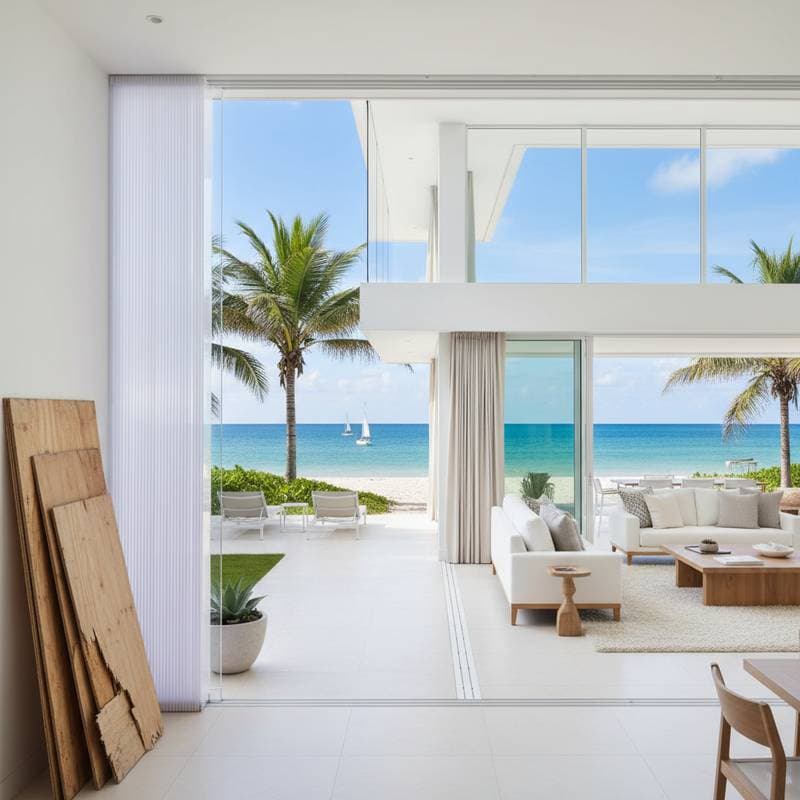Why Transparent Shutters Beat Plywood for Beach Homes
Beach homes endure relentless exposure to salt-laden air, high humidity, and severe storms. Safeguarding windows against flying debris remains a critical concern, prompting homeowners to weigh traditional plywood against innovative transparent shutters. Transparent storm shutters constructed from polycarbonate materials deliver unmatched visibility, durability, and user-friendliness over plywood. These shutters ensure ongoing protection while preserving natural light and unobstructed coastal vistas, positioning them as the optimal selection for enduring coastal challenges.
Understanding Transparent Storm Shutters
Transparent shutters consist of impact-resistant polycarbonate panels engineered to guard windows from wind-driven debris in tropical storms or gale-force winds. Distinct from plywood, these panels permit light transmission while securing the structure.
The average installation cost for transparent shutters spans $20 to $35 per square foot. Plywood panels, in contrast, range from $2 to $5 per square foot. Despite the elevated upfront expense, transparent shutters yield substantial economies through reduced maintenance, repeated usability, and operational simplicity over extended periods.
Image: Modern beach home with transparent polycarbonate shutters letting in natural light
Comparing Transparent Shutters and Plywood
The following table delineates essential distinctions in performance and utility between the two options.
| Feature | Transparent Shutters (Polycarbonate) | Plywood Panels |
|---|---|---|
| Visibility | Full light and view maintained | Completely blocks light |
| Durability | Resists cracking, UV damage, and salt corrosion | Warps or rots when exposed to moisture |
| Installation | Permanent or quick-mount systems | Manual installation required each time |
| Maintenance | Minimal, only occasional cleaning | Must be replaced frequently |
| Aesthetic Value | Clean, modern look | Rough, temporary appearance |
| Reusability | Can last many years | Often discarded after few uses |
This comparison reveals that plywood may seem economical at first glance, yet transparent shutters surpass it across vital aspects relevant to seaside residences.
Image: Close-up of polycarbonate storm shutter resisting high wind impact
Why Polycarbonate Shutters Excel in Coastal Environments
1. Light and Visibility
Plywood installation during storm readiness eliminates all daylight, rendering interiors dim and confining. Transparent shutters maintain natural illumination, enabling residents to remain secure and at ease within the home without relying on supplemental lighting sources.
2. Strength and Impact Resistance
Polycarbonate, the material employed in aircraft canopies and protective shields, endures multiple strikes without fracturing. This resilience suits properties in regions prone to forceful coastal gusts. Plywood, exposed to dampness, tends to splinter, fracture, and lose integrity progressively, compromising its shielding effectiveness.
3. Long-Term Durability
Transparent storm shutters withstand corrosion, ultraviolet radiation, and saline intrusion. Plywood absorbs ambient moisture and degrades rapidly in saturated seaside atmospheres. Across multiple seasons, recurring plywood replacements accumulate expenses, whereas polycarbonate units preserve transparency and robustness for decades.
Image: Coastal home protected by transparent storm shutters during heavy rain
Energy Efficiency and Comfort Benefits
Beyond shielding from winds and projectiles, transparent shutters enhance insulation and thermal regulation. Sealed panels minimize drafts when deployed, retaining conditioned air amid scorching conditions. Plywood, conversely, retains heat and humidity, fostering oppressive indoor environments.
Certain polycarbonate designs incorporate ultraviolet-blocking layers that diminish glare without impeding light passage. Such attributes prove advantageous in beach settings where prolonged solar exposure predominates.
Ease of Installation and Everyday Convenience
Plywood deployment demands considerable time, equipment, and exertion. Panels require individual fastening prior to inclement weather and subsequent disassembly. Transparent shutters support permanent fixtures or swift-track mechanisms, streamlining preparation to mere minutes.
Full-time coastal dwellers benefit immensely from this efficiency. It obviates frantic pre-storm efforts and prevents structural harm from repeated nailing into window surrounds.
Image: Homeowner easily securing transparent storm shutters before a coastal storm
Long-Term Value and ROI
Transparent shutters command a premium initially, yet they generate compelling returns via longevity, security, and visual allure.
| Cost Factor | Transparent Shutters | Plywood |
|---|---|---|
| Initial Cost | Higher | Low |
| Maintenance Cost | Low | High |
| Lifespan | 10+ years | 1–2 years |
| ROI (Resale Value) | 70–80% | Minimal |
Prospective buyers prioritize established storm defenses. Transparent shutters elevate exterior presentation, indicating meticulous upkeep and preparedness for seasonal threats.
FAQs About Transparent Storm Shutters
Q: Are transparent shutters as strong as metal ones?
Yes. Polycarbonate shutters meet or exceed most building code requirements for impact resistance.
Q: Do they turn yellow over time?
High-quality polycarbonate shutters include UV inhibitors that prevent yellowing or cloudiness.
Q: Can I install them myself?
Many systems are designed for DIY installation, though professional fitting ensures maximum protection.
Safeguard Your Seaside Sanctuary with Confidence
Selecting transparent shutters equips beach homeowners to confront environmental rigors head-on. These installations blend robust defense with everyday livability, ensuring uninterrupted enjoyment of ocean panoramas. Invest in polycarbonate protection today to fortify your property against tomorrow's uncertainties.

